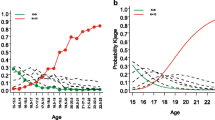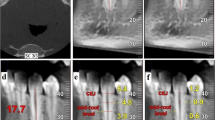Abstract
The performance of age estimation methods may vary due to a combination of method- and sample-related factors. Method development and evaluation necessitates understanding what influences these factors have on age estimation outcomes. In the specific context of juvenile dental age estimation, we used a single dataset and complete factorial design to systematically test four potential sources of difference: age distributions of reference and target sample (uniform, unimodal, U-shaped), Bayesian (multivariate Bayesian cumulative probit) vs. classical regression modeling (multivariate adaptive regression splines i.e. MARS), and model selection bias. The dataset consisted of 850 sets of left mandibular molar scores from London children 5–18 years old. True age and estimated age intervals in target samples were compared for bias, root-mean-squared error, precision, and accuracy using locally weighted smoothing of performance measures across the age range and means of performance metrics between factor-level combinations. We found interactions of model type, reference distribution, and target distribution. MARS models showed consistent evidence of age mimicry. Central tendency of the reference sample corresponded with increased bias while central tendency of the target sample corresponded with reduced RMSE and reduced precision for both model types. We found evidence of model selection bias, mitigated through averaging model metrics. We conclude that reference and target sample distribution influences and model selection bias are sufficient to cause difference in model performance within a single population. We suggest using Bayesian modeling, drawing uniform reference and target samples, and calculating test error on a hold-out sample to mitigate these challenges in method development.




Similar content being viewed by others
Data availability
The dataset analyzed during the current study is available from the second author on reasonable request.
References
Adams DM, Ralston CE, Sussman RA et al (2019) Impact of population-specific dental development on age estimation using dental atlases. Am J Phys Anthropol 168:190–199
Kırzıoğlu Z, Ceyhan D (2012) Accuracy of different dental age estimation methods on Turkish children. Forensic Sci Int 216:61–67
Jayaraman J, Roberts GJ, Wong HM, King NM (2018) Dental age estimation in southern Chinese population using panoramic radiographs: validation of three population specific reference datasets. BMC Med Imaging 18:1–8
Khdairi N, Halilah T, Khandakji MN et al (2019) The adaptation of Demirjian’s dental age estimation method on North German children. Forensic Sci Int 303:109927
Baghdadi ZD, Pani SC (2012) Accuracy of population-specific Demirjian curves in the estimation of dental age of Saudi children. Int J Pediatr Dent 22:125–131
Corron L, Marchal F, Condemi S, Adalian P (2018) A critical review of sub-adult age estimation in biological anthropology: do methods comply with published recommendations? Forensic Sci Int 288:328. e1–328. e9
Buckberry J (2015) The (mis) use of adult age estimates in osteology. Ann Hum Biol 42:323–331
Nikita E, Nikitas P (2019) Skeletal age-at-death estimation: Bayesian versus regression methods. Forensic Sci Int 297:56–64
Bullock M, Márquez L, Hernández P, Ruíz F (2013) Paleodemographic age-at-death distributions of two Mexican skeletal collections: a comparison of transition analysis and traditional aging methods. Am J Phys Anthropol 152:67–78
Bocquet-Appel JP, Masset C (1982) Farewell to paleodemography. J Hum Evol 11:321–333
Sgheiza V (2022) Conditional independence assumption and appropriate number of stages in dental developmental age estimation. Forensic Sci Int 330:111135
Mays S (2015) The effect of factors other than age upon skeletal age indicators in the adult. Ann Hum Biol 42:332–341
Liversidge HM, Smith BH, Maber M (2010) Bias and accuracy of age estimation using developing teeth in 946 children. Am J Phys Anthropol 143:545–554
Prince DA, Konigsberg LW (2008) New formulae for estimating age-at-death in the Balkans utilizing Lamendin’s dental technique and Bayesian analysis. J Forensic Sci 53:578–587
Tangmose S, Thevissen P, Lynnerup N, et al (2015) Age estimation in the living: transition analysis on developing third molars. Forensic Sci Int 257:512. e1–512. e7
Valsecchi A, Olivares JI, Mesejo P (2019) Age estimation in forensic anthropology: methodological considerations about the validation studies of prediction models. Int J Legal Med 133:1915–1924
Cawley GC, Talbot NL (2010) On over-fitting in model selection and subsequent selection bias in performance evaluation. J Mach Learn Res 11:2079–2107
Moorrees CF, Fanning EA, Hunt EE Jr (1963) Age variation of formation stages for ten permanent teeth. J Dent Res 42:1490–1502
Schmeling A, Geserick G, Reisinger W, Olze A (2007) Age estimation. Forensic Sci Int 165:178–181
Herrera MJ, Retamal R (2017) Reliability of age estimation from iliac auricular surface in a subactual Chilean sample. Forensic Sci Int 275:317. e1–317. e4
Gage TB (1988) Mathematical hazard models of mortality: an alternative to model life tables. Am J Phys Anthropol 76:429–441
Gage TB (1990) Variation and classification of human age patterns of mortality: analysis using competing hazards models. Human Biology 589–617
Finkelhor D, Ormrod R (2001) The homicides of children and youth. Out of the darkness: Contemporary perspectives on family violence 17–19
National Institute of Justice (2020) National missing and unidentified persons system. In: NamUs. namus.gov. Accessed 15 May 2020
Edgar H, Daneshvari Berry S, Moes E, et al (2020) New Mexico Decedent Image Database (NMDID). https://doi.org/10.25827/5S8C-N515
Gunst K, Mesotten K, Carbonez A, Willems G (2003) Third molar root development in relation to chronological age: a large sample sized retrospective study. Forensic Sci Int 136:52–57
Galić I, Vodanović M, Janković S et al (2013) Dental age estimation on Bosnian-Herzegovinian children aged 6–14 years: evaluation of Chaillet’s international maturity standards. J Forensic Leg Med 20:40–45
Urzel V, Bruzek J (2013) Dental age assessment in children: a comparison of four methods in a recent French population. J Forensic Sci 58:1341–1347
Klein H, Palmer CE, Kramer M (1937) Studies on dental caries. II. The use of the normal probability curve for expressing the age distribution of eruption of the permanent teeth. Growth 1:20
Bera AK, Jarque CM, Lee L-F (1984) Testing the normality assumption in limited dependent variable models. International economic review 563–578
Johnson PA (1996) A test of the normality assumption in the ordered probit model. Metron 54:213–221
Konigsberg LW, Frankenberg SR, Liversidge HM (2016) Optimal trait scoring for age estimation. Am J Phys Anthropol 159:557–576
Hirk R, Hornik K, Vana L (2020) mvord: an R package for fitting multivariate ordinal regression models. J Stat Softw 93:1–41
Friedman, JH (1991) Multivariate adaptive regression splines. Ann Stat 19(1):1–67
Milborrow S (2011) Derived from mda:mars by T. Hastie and R. Tibshirani. earth: Multivariate Adaptive Regression Splines, R package. http://CRAN.R-project.org/package=earth
Bayliss MB, Zengo K, Ruel J et al (2017) Velocity segregation and systematic biases in velocity dispersion estimates with the SPT-GMOS spectroscopic survey. Astrophys J 837:88
Isaksson A, Wallman M, Göransson H, Gustafsson MG (2008) Cross-validation and bootstrapping are unreliable in small sample classification. Pattern Recogn Lett 29:1960–1965
Erdős P, Lacampagne CB, Selfridge JL (1993) Estimates of the least prime factor of a binomial coefficient. Math Comput 61:215–224
Hoppa RD, Vaupel JW (2002) The Rostock Manifesto for paleodemography: the way from stage to age. Cambridge Studies in Biological and Evolutionary Anthropology 1–8
Sgheiza V, and Helen ML (2021). The Effect of Reference Sample Composition and Size on Dental Age Interval Estimates. In Program of the 90th annual meeting of the Am Assoc Biol Anthropologists 174:95–95
Bagherpour A, Imanimoghaddam M, Bagherpour MR, Einolghozati M (2010) Dental age assessment among Iranian children aged 6–13 years using the Demirjian method. Forensic Sci Int 197:121. e1–121. e4
AlQahtani SJ, Hector MP, Liversidge HM (2010) Brief communication: the London atlas of human tooth development and eruption. Am J Phys Anthropol 142:481–490
Nawrocki SP (2010) The nature and sources of error in the estimation of age at death from the skeleton. Age estimation of the human skeleton 79–101
Milner GR, Boldsen JL (2012) Transition analysis: a validation study with known-age modern American skeletons. Am J Phys Anthropol 148:98–110
Author information
Authors and Affiliations
Corresponding author
Ethics declarations
Ethics approval
Ethical approval was waived by the University of Illinois at Urbana-Champaign Institutional Review Board in view of the retrospective nature of the study, and all the procedures being performed were part of the routine care.
Informed consent
Not applicable.
Conflict of interest
The authors declare no competing interests.
Additional information
Publisher's note
Springer Nature remains neutral with regard to jurisdictional claims in published maps and institutional affiliations.
Supplementary Information
Below is the link to the electronic supplementary material.
Rights and permissions
Springer Nature or its licensor (e.g. a society or other partner) holds exclusive rights to this article under a publishing agreement with the author(s) or other rightsholder(s); author self-archiving of the accepted manuscript version of this article is solely governed by the terms of such publishing agreement and applicable law.
About this article
Cite this article
Sgheiza, V., Liversidge, H. Reference and target sample age distribution impacts between model types in dental developmental age estimation. Int J Legal Med 137, 383–393 (2023). https://doi.org/10.1007/s00414-022-02925-8
Received:
Accepted:
Published:
Issue Date:
DOI: https://doi.org/10.1007/s00414-022-02925-8




